|
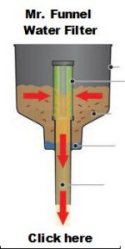
WICKS TO FIT THE HEATERS LISTED
BELOW - AND MORE!
Unique Specialty wicks
for
19th Century lamps
|
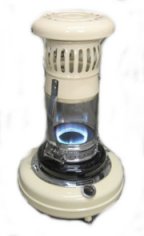
 . . . .
World's Largest Selection of Wicks!
Wicks for virtually every heater, stove and lamp made since 1850
KEROSENE FUEL PRIMER
Kerosene defined - Red
Dye Kerosene - Mineral
Spirits - High Sulfur
Kerosene - Jet Fuel -
Water in Kerosene - Liquid Paraffin Lamp Oil - Kerosene Storage - Large
Storage Tanks - Possible tax
rebate for home use of clear kerosene
Burning diesel
fuel in kerosene heaters using All-cotton wicks. Click here.
|
I
have received many reports of flame "dwindling" or
poor performance of heaters. This is caused
by poor capillary action, the result of water in
the fuel: It only takes a teaspoon of accumulated
water to saturate the cotton lower portion of a
wick.
Click here for the solution.
|
|
CLEANING THE KEROSENE SMELL OFF YOUR
HANDS
Handling kerosene means some
will get on your hands, and it has a distinctive
aroma. Because kerosene is an
penetrating oil, regular detergent often does not
completely eliminate the aroma. Thick,
cheap hair shampoo, or a women's facial cleanser,
will dissolve the kerosene quickly and
easily. Any lingering kerosene aroma can be
removed by using the new "hand sanitizer," which is
an emulsified solution of glycerin, alcohol and
water. When your hands are still damp and
rinsed from using the shampoo, put on some "hand
sanitizer," rub your hands together, then rinse and
dry, leaving your hands smelling nice and
fresh. A bit of trouble, but necessary for
those of us using kerosene heaters.
|
Daily reminders
by our benevolent leaders on every danger imaginable has
created a population afraid of almost everything. So it
is with those new to kerosene as a fuel and
kerosene-fueled heaters and cookers. But kerosene
products have been around for over a century and are safe
to use with only the usual precautions required for
anything that generates heat.
Abraham Pineo Gesner (May 2, 1797 - April 29, 1864)
was a Canadian physician and geologist who invented
kerosene. Although Ignacy Lukasiewicz developed the
modern kerosene lamp, starting the world's oil industry,
Gesner is considered a primary founder. Gesner was born
in Cornwallis, Nova Scotia. He died in Halifax, Nova
Scotia. Gesner's research in minerals resulted in
his 1846 development of a process to refine a liquid
fuel from coal. His new discovery, which he named
kerosene, burned cleaner and was less expensive than
competing products, such as whale oil. In 1850, Gesner
created the Kerosene Gaslight Company and began
installing lighting in the streets in Halifax and other
cities. By 1854, he had expanded to the United States
where he created the North American Kerosene Gas Light
Company at Long Island, New York. Demand grew to where
his company's capacity to produce became a problem, but
the discovery of petroleum, from which kerosene could be
more easily produced, solved the supply problem. Abraham
Gesner continued his research on fuels and wrote a number
of scientific studies concerning the industry including
an 1861 publication titled, "A Practical Treatise on
Coal, Petroleum and Other Distilled Oils," which became a
standard reference in the field. Eventually, Gesner's
company was absorbed into the petroleum monopoly,
Standard Oil and he returned to Halifax, where he
was appointed a Professor of Natural History at Dalhousie
University.[4][5]
John D. Rockefeller's Standard Oil Company controlled 4%
of the kerosene market in 1870, refined from crude
oil. There were still many regional refineries up
until about 1900, but most of them were squeezed out of
the market and absorbed by Standard Oil's intense
anti-competitive actions. Even though refined from
crude oil, the kerosene was still made to replicate the
burning characteristics of coal oil. And coal oil
quality varied by the coal from which it was produced,
and the early crude oil refineries also produced
"kerosene" of varying quality and burning
characteristics.
"Coal Oil" virtually
ceased to exist. Lamps were still known as "oil
lamps," of course, because they had been designed to burn
coal oil. Coal is a mineral, and
by crushing and steaming the coal, the "essence" of the
coal was obtained, it's "spirit," in the form of an
oil. And that became mineral spirits, a vastly more
pure product for use in wick appliances. If from
low sulfur content coal, it became "Low Odor Mineral
Spirits." The Amish still use nothing but Low Odor
Mineral Spirits in their center draft
lamps. (Note: Home Depot is
selling "Green" Mineral Spirits. That junk is milky, not clear,
and burns horribly. It is NOT clear Low Odor Mineral Spirits.)
On Jan. 15, 1885, Leonard
Henkle patented the flame spreader which would make
possible the efficient use of center draft lamps.
The Henkle patent was purchased by Charles Upton. By the
summer of 1884 Upton had standardized various sizes of
lamps (0, 1, 2 and 3) and was selling lamps made for him
by Edward Miller under the trade name Rochester Lamp
Company. Those lamps were designed to burn coal oil
- Low Odor Mineral Spirits. They had metal fonts with a center
draft tube which cooled the fuel as they burned.
In 1888
the Cleveland Foundry Company was formed. They
manufactured a line of oil lamp stoves, along with many
lamp companies such as
Bradley & Hubbard and Miller.
In 1894, the plant started producing portable
heaters. These heaters used the "store
lamp" wick that had been standardized by Rochester in
1884. In 1901 Francis Drury approached
John D. Rockefeller of Cleveland, owner of Standard Oil
Company. At the time Standard Oil was delivering kerosene
to homes and businesses for use in kerosene lamps.
Rockefeller knew that with use of the Drury Stove the
demand for this kerosene would increase substantially and
it did. Rockefeller selected the company to design,
develop and manufacture for it a complete line of stoves
which were to be sold under the name "Perfection" to
dealers by a group of 300 Standard Oil salesmen. This
arrangement was continued by other oil
companies.
By the early 1900's, Standard Oil Company had a virtual
monopoly on kerosene production. Desiring to branch
out with a lamp to burn their "new" kerosene, they
purchased the rights to sell an existing Bradley &
Hubbard lamp. Introduced at the 1904 St. Louis
World's Fair, the Standard Oil "Perfection" lamp looked
promising, and the following year saw sales of the lamp
renamed "Rayo" at Standard Oil distributors. (The
"Perfection" name was owned by the Cleveland Foundry
Company, which is why the name was changed to
Rayo.) Production of the Rayo lamp continued at the
B&H factory in Meriden, CT until the great flood of
August, 1955 totally destroyed the river-front
factory.
|
The widespread use of internal
combustion engines in automobiles and trucks actually started
during WW I. Refineries began extracting more gasoline from
crude oil and the leftovers were made into kerosene. The
quality and volatility of kerosene dropped considerably. The
KeroSafe advertisement from 1918 shown at right mentions that
problem. |
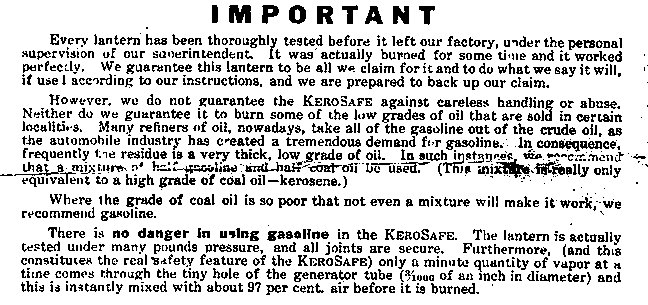
Click photo ^ to enlarge. |
So, we have center draft
lamps designed to burn coal oil, are called "oil lamps,"
and now were burning Standard Oil's "kerosene."
Note the very careful wording - "center draft
lamps." Low Odor Mineral Spirits should not
be used in lanterns or flat wick
lamps - just larger
metal fount center draft lamps designed in the
1880's. The Aladdin mantle lamp was not designed
until 1907 and was intended for use with kerosene.
See more on Low Odor Mineral Spirits below.
Propaganda. For a hundred years or more, we
have been conditioned to believe that kerosene "oil"
lamps are supposed to burn "kerosene." And
for the past 25 years, another layer of propaganda would
have us believe that only $20 per gallon "Liquid Paraffin
Lamp Oil" should be burned in lamps.
Bullpucky.
Kerosene is
NOT like gasoline: it is a lubricant, not corrosive,
not volatile, and extremely stable in storage. The
specific gravity of kerosene is about 0.8, and its
ignition point is more than 104 F. If you throw a match
into a pool of kerosene it will put out the match. You
can hold a match right up to the edge of a teaspoon half
full of kerosene and it will not ignite (try that with
gasoline and you will need to grow
new eyebrows).
|
http://columbia.thefreedictionary.com/kerosine
kerosene or
kerosine, colorless, thin mineral oil whose
density is between 0.75 and 0.85 grams per cubic
centimeter. A mixture of hydrocarbons, it is
commonly obtained in the fractional distillation
of petroleum as the portion boiling off between
150 C; and 275 C; (302 F; 527 F;). Kerosene has
been recovered from other substances, notably
coal (hence another name, coal oil), oil shale,
and wood. At one time kerosene was the most
important refinery product because of its use in
lamps. Now it is most noted for its use as a
carrier in insecticide sprays and as a fuel in
jet engines.
Thesaurus
Noun 1. kerosene - a flammable hydrocarbon oil
used as fuel in lamps and heaters
coal oil, kerosene, lamp oil
fuel - a substance that can be consumed to
produce energy; "more fuel is needed during the
winter months"; "they developed alternative fuels
for aircraft"
hydrocarbon - an organic compound containing only
carbon and hydrogen
paraffin oil, paraffin - British usage
|
Kerosene may
be safely stored in plastic
containers, oil drums, old diesel tanks -- just about
anything that doesn't leak. Kerosene should be stored in
blue containers, as red indicates gasoline. Kerosene does
expand and contract slightly with ambient temperatures,
so steel tanks should be vented or have some "head space"
left in the tank. Plastic containers are designed to have
room for expansion, so they may be filled to the lowest
edge of the fill hole safely.
Ideally, kerosene
should be stored under cover in a ventilated tank. Five
gallon kerosene containers should be on secure shelving
in an outside shed or barn - never in sunlight, as that
quickly degrades the kerosene. Obviously you should not
store flammable liquids in the home, as that would
violate every fire insurance and code regulation that
exists and a few new ones as well. To
emphasize a point, kerosene
containers should be blue so they cannot be
confused with gasoline containers, which are red.
The grade of
kerosene required by modern kerosene appliances is No.
1-K, which can be either red or clear. The red dye was
added by a Clinton Administration edict in July, 1998, so
people using kerosene to fuel their diesel engine
vehicles would be easy to spot by the police for not
paying the road tax on motor fuels. Sure. Like a cop is
going to siphon fuel out of your tank to check what color
it is. It is just one more idiotic,
unconstitutional edict (see the Tenth Amendment) we are
stuck with. [A reader in Holland told me the
police actually DO set up roadblocks and check the fuel
color to make sure the road tax has been paid, so I guess
we are lucky so far.]
While on the subject of
governmental interference, I should mention that we get
the crud now for kerosene. When the fed burrorats
insisted on low sulfur diesel for 18 wheelers, the govt
workers forgot they cannot regulate nature or the market
place. It's not like some bureaucrat can turn off the
sulfur content of North Slope oil, nor is it likely that
it would go unused because of the high sulfur content. So
the market switched products to match the whims of the
politically correct bureaucrats. Now, diesel engines get
the sweet, light low-sulfur diesel (and they could not
care less), while we get to burn high sulfur kerosene in
our homes. And it's not just kerosene. Home heating fuel
is now high sulfur crud. So instead of 18 wheelers
belching sulfur dioxide, now it is emitted by every home
in America that heats with oil. The amount of "oil"
consumed remains the same, the amount of sulfur dioxide
emitted remains the same, but enviro wacko's can marvel
at how they changed things and "reduced emissions" when
in fact the net effect is zero.
Marvelous.
Red dye or clear...is
there a difference? Yes. Without a doubt.
Red dye kerosene is usually delivered in bulk quantities
by a fuel oil supplier, and is known in the trade as #1
stove oil. Clear 1-K kerosene in bulk quantities is
very difficult to find in many areas of the country, AND
it often costs at least a dollar a gallon more than red
dye #1 stove oil (kerosene). There is no free
lunch. The red dye kerosene requires more frequent
dry burns, and in heaters with a short catalytic
burner unit it does not burn as
cleanly.
Adding an
eyedropper full (1/3rd teaspoon) of 91%+ alcohol per
gallon of red dye kerosene helps to keep the wick
cleaner. It may well shorten the life of the wick a
little, but the savings in price compared to 1-K clear
makes that a small cost indeed. Pure alcohol is
available in most hardware stores - look for Shellac
thinner or Denatured Alcohol.
If you are using kerosene
only for lamps, clear
1-K kerosene can be purchased in hardware stores for $8
or more per gallon -- but you will not be using enough of
it to make much of a difference in cost. The clear
will burn cleaner in lamps then red dye kero, and the
wicks will last longer.
NOTE: I have
absolutely no agenda on lamp fuels. You can
burn whatever the heck you wish to burn in your
lamps. Some people seem to think that one fuel is
so vastly superior to all others they will aggressively
attack all other fuels. I refuse to engage them,
nor will I get into a debate on the merits of their
position. The information on this page is strictly
my opinion. My only goal is clean burning, long
wick life, and safe burning conditions. If you wish
to burn expensive "Liquid Paraffin" and ruin the
capillary action of the wick, or burn 1K kerosene and
have rapid charring of the wick and therefore short wick
life, that is fine with me - I will happily sell
you new wicks. But I like long wick life, a bright
light, as little charring of the wick top as possible,
with a safe and inexpensive fuel. You may do as you
wish as it is your lamp, your wick and your
responsibility. Peace be with you. Go with
God. Whatever happens it ain't my fault.
The best fuel for
metal font center draft
lamps in my opinion is Low Odor Mineral Spirits, as it costs less than 1-K
clear kerosene and burns unbelievably cleaner, so clean
the wicks seldom even need to be trimmed. Some
specialty center draft wicks are made for me in low
quantities and are thus expensive, so this is an
important factor! In center draft and Kosmos lamps
(with metal fonts), you will be amazed at the quality of
the burn and the lack of any char on the wick.
Unlike kerosene which precipitates paraffin, Low Odor
Mineral Spirits are absolutely pure and leave a font
perfectly clean and clear. I was tipped on this
fuel by the Amish, who have used it for decades for their
"kerosene" lamps. I purchase Low Odor
Mineral Spirits from my local True Value Hardware store,
item #507327. I order a 6 gallon case and receive it a
week later, for which I receive a 10% discount. The cost
the last time I purchased some (September, 2011) was
$6.89 per gallon. Note:
Low Odor (or "Odorless") Mineral Spirits can be
used as a paint thinner for oil based paints and thus the
container is often marked "Paint Thinner, Low Odor
Mineral Spirits." There are 39 varieties of paint
thinners but only one Low Odor Mineral Spirits.
Some paint thinners are quite volatile: please
do not get "creative" and assume that anything which
will burn is a suitable fuel for any lamp under any
condition. There is a reason why center draft lamps
have metal founts - to dissipate heat properly and avoid
excess fuel temperature and thus volatile
vapors.
|
Note:
There is a vast difference between center draft
lamps and flat wick lamps and lanterns!
Center draft lamps were precision
made, so there is little wick gap and thus few
vapor fumes escape past the wick. Flat wick
lamp burners were always cheap, with excess wick
gap and often a vent for fuel vapor directly to the
top of the burner. Center draft lamps always
have a metal fount that dissipates heat.
Use
only 1K clear kerosene in flat wick
lamps.
|
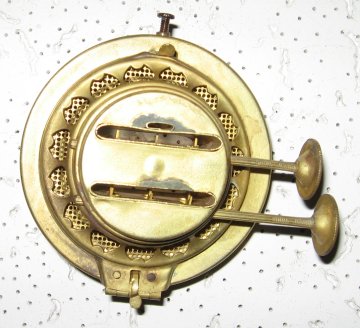
|
|
Dietz-style lanterns have flat
wicks and tubes along the sides
which recycle the hot exhaust from the top of the
lantern back into the fuel fount, raising the fuel
temperature and lowering fuel viscosity, causing
excess volitility. Woody Kirkman does
not recommend Mineral Spirits in Dietz
lanterns. Woody is the undisputed King of
lanterns - please take his advice.
DO NOT
USE MINERAL SPIRITS IN FLAT WICK LANTERNS OR
LAMPS!
|
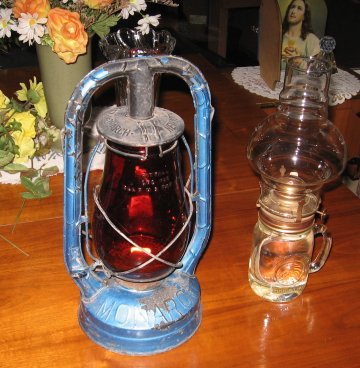
|
KEROSENE VERSUS OTHER
FUELS
*1
http://www.carsonoil.com/graphics/msds/MSDSJetFuel.pdf
(Tesoro)
*2
http://www.hess.com/EHS/msds/Kero_Dyed_9912_clr.pdf
(Amerada Hess)
*3
http://www.arfarfarf.com/msds/000006.php (Spectrum
Chemical Mfg.)
*4
http://www.spragueenergy.com/documents/MSDSKerosene.pdf
(Spargue)
*5
http://www.ertco.com/msds_redspirit.html (Mallinckrodt
Chem)
*6
http://www.mapllc.com/msds/0121MAR019.pdf
(Marathon)
*7
http://www.jtbaker.com/msds/englishhtml/k2175.htm (J.T.
Baker)
*8
http://www.dick-blick.com/msds/DBH_01032.pdf
(Crown)
*9
http://www.sunnysidecorp.com/MSDS/pdf/msds705.pdf
(Sunnyside)
*10
http://www.eezimmermanco.com/MSDS/E-Z%20ODORLESS%20MINERAL%20SPIRITS.pdf
(Zimmerman)
*11
http://www.wescoweb.com/Wesco105MSDS%20D43.pdf (Shell)
(Solvent Naphtha, medium Aliphatic)
*12
http://avogadro.chem.iastate.edu/MSDS/msds805.pdf
(Sunnyside)
*13
http://www.mapllc.com/MSDS/0248MAR019.pdf
(Marathon)
*14
http://www.proschoice.com/OMS.pdf (Chemical
Technologies International) (Upholstery cleaner)
*15
http://intranet.risd.edu/envirohealth_msds/PhysicalPlant/RecochemOdourlessPaintThinner.pdf
(Recochem) (Canada)
*16
http://www.wmbarr.com/msds/QKSP94005.pdf
(KleenStrip)
An example of an
odorless paint thinner product in the US:
http://www.sunnysidecorp.com/gold.htm
http://www.kleanstrip.com/paintprep.htm
Jet A fuel
is extremely close to kerosene and burns well in kerosene
heaters, and therefore is the fuel of choice for those
who heat with kerosene heaters in many remote areas of
Canada and Alaska. In northern climes, anti-icing
additives are often added at the pump nozzle instead of
being pre-mixed with the fuel: Don't get the
additives when obtaining Jet A for kerosene heater
use. NOTE: Jet A is not
the same as JP-4. Do not use JP-4 in a kerosene
heater. www.csgnetwork.com/jetfuel.html
Diesel fuel
burns with fumes and smoke, carbons up the wick very
quickly, and ruins wicks incredibly fast. Most lots
of #1 Stove Oil are red dye kerosene, but some can have a
little light oil from previous use of the fuel dealer's
tank, burn with fumes and carbon the top of the wick
faster.
Examples are in
order. My Valor Valmin is a flame spreader
design heater. Burning 1K clear kerosene, the
cotton wick needs to be trimmed and cleaned often, and
there is a mild though distinct aroma of kerosene when it
is burning. When burning Low Odor Mineral Spirits,
there is no aroma at all and the wick never needs to be
trimmed or cleaned. My Aladdin TR2000 is a
catalytic converter type heater with a fiberglass wick,
and just happens to be a design that is hard on
wicks. Burning 1K clear kerosene, the wick needs to
be burned dry after about seven tanks of fuel.
Burning #1 stove oil (red dye kerosene), the wick needs
to be burned dry every three or four tanks of fuel
burned. Burning Low Odor Mineral Spirits, the wick
may need to be burned dry after three or four months of
daily use - maybe, as it shows no signs of tar or
degradation of capillary action after two months of daily
use burning Low Odor Mineral Spirits.
All "wickless" oil
stoves and ranges, which actually have
edge-burning wicks, will have vastly cleaner burning
characteristics and longer wick life if nothing but Low
Odor Mineral Spirits are used in them, particularly now
that product liability lawyers have destroyed the
asbestos industry and fiberglass edge-burning
wicks are the only wicks available.
STORAGE LIFE
Kerosene
stored in a plastic container should be used within a
year. Kerosene stored in a metal container or tank
in a rain-proof shed or underground can be stored for
DECADES. Jet fuel is literally stored for decades
in underground concrete tanks bigger than football fields
and then used in hundred-million dollar aircraft without
a problem. Mineral Spirits stored in the
original container - out of sunlight - will be perfectly
good after years of storage.
GASOLINE IS VOLATILE AND SHOULD NOT BE
USED IN A KEROSENE HEATER !
Kerosene
heaters burn at 90% or greater efficiency and at 90%
or greater maximum setting, so the "flame front" is just
above the top of the wick and tar ball deposits build up
more slowly. Using clear 1-K kerosene, the wick in
a kerosene heater may only have to be "burned dry" once or twice
a month, and it was common for wicks to last for several
years. When burning red dye #1 stove oil, the wick must
be "burned dry" to remove tar deposits once a week or so,
and wicks can last for only a season or two, depending on
the wick and catalytic converter design. There is no
doubt: burning 1-K clear kerosene instead of #1 stove oil
in a kerosene heater is more convenient and results
in a longer wick life.
Now we must consider the
economics involved. The most economical method of heating
is with kerosene space heaters -- if #1 stove oil
is purchased in bulk, delivered to your tank. On
January 14th, 2003, I had red dye #1 stove oil delivered
to top up my tanks because I knew we were going to war
with Iraq, and oil prices would be skyrocketing. It
cost me $1.29.8 per gallon, for a total price of
$176.65. I could have had clear 1-K kerosene
delivered instead, but the cost would have been $2.34 per
gallon, or $318.24. In one-half of one winter
heating season, I saved $141.59 by using red dye
kerosene!!!
On March 11, 2003, a
friend in New Jersey told me that clear 1-K kerosene was
available there in bulk for $1.60. Almost made me
cry, as that is about half the current price of red dye
kerosene in Oregon. Obviously, there are regional
price differentials that you should factor into which
fuel to burn. My personal cut-off level would be
about 25 cents per gallon more for 1-K clear, strictly
from an economic point of view.
In October, 2011, the cost
of #1 Red Dye stove oil is $4.29 per gallon, the cost
doubling in two years of the anti-oil agenda of the Obama
Administration.
HIGH SULFUR CONTENT
KEROSENE
|
In some areas
kerosene is actually getting cleaner, while other
areas are not so lucky. When the sulfur
content is very high, as from kerosene refined
from Alaskan crude, a white powdery residue can
be found on the catalytic converter of radiant
heaters and the top plate of convection
heaters, as shown at right. The steel
catalytic converter is from an Aladdin Tropic,
sitting on the top plate of a KOGY 100 convection
heater. The white powder is rather
obvious. Heaters with short catalytic
converters cannot handle high sulfur kerosene
without a distinctive aroma when burning.
It is best to avoid such fuel if possible.
Click to enlarge.
|
 |
Fuel dye
in North America
In United States of America, the
Environmental
Protection Agency mandates use of a red dye to
identify high-sulfur fuels for off-road use. Solvent Red 26 is used in the
United States as a standard, though it is often
replaced with Solvent Red 164, which is similar
to Solvent Red 26 but with longer alkyl chains. The Internal Revenue
Service mandates use of the same red dyes, in
fivefold concentration, for tax-exempt diesel fuels
such as heating oil; their argument for the
higher dye content is to allow detection even when
diluted with "legal" fuel. Detection of red-dyed fuel
in the fuel system of an on-road vehicle will incur
substantial penalties.
http://en.wikipedia.org/wiki/Fuel_dyes
LOW SULFUR, CLEAR KEROSENE AT SERVICE STATION
PUMPS
(From Ray Wassell,
2.4.2012)
Sunoco has
on their kerosene pumps "Ultra Low Sulfur less then
10ppm. Required for all vehicles 2007 and later". I
believe it's taxed but will have to double check. I
know it's $4.75 a gallon and has a very slight yellow
tint. I wouldn't have noticed the color except I put
some in a clear bottle to fill a lamp. I have tried it
from 2 local stations and both had the yellow
tint.
Hess
labels their pump "Low Sulfur Kerosene. Less then
500ppm Sulfur. Undyed and untaxed. For Nontaxable use
only". It used to say "Federal law prohibits use
in vehicles 2007 and later" but that wasn't posted
thursday when I went last. I can't exactly remember
what the new shorter label said in it's entirety. Next
time I'll take a picture.
You can only
get untaxed, undyed kero from a "registered
ultimate vendor" (irs term)with a blocked pump. Here's
some info I found about "blocked" pumps:
Blocked
pump. A blocked pump is a fuel pump that meets
all the following requirements.
- It is
used to make retail sales of undyed kerosene for use by
the buyer in any nontaxable use.
- It is at
a fixed location.
- It is
identified with a legible and conspicuous notice
stating, "UNDYED UNTAXED KEROSENE, NONTAXABLE USE
ONLY."
-
It meets
either of the following conditions.
- It
cannot reasonably be used to dispense fuel directly
into the fuel supply tank of a diesel-powered
highway vehicle or train.
- It is locked by the
vendor after each sale and unlocked by the vendor
only in response to a buyer's request for undyed
kerosene for use other than as a fuel in a
diesel-powered highway vehicle or
train.
BE CAREFUL USING MINERAL
SPIRITS IN A LAMP!
Use at your own discretion
only.
Our concern/question is about fuel or
lamp oil. I have been looking for a source for the low
odor mneral spirits and came across several web
conversations that have me concerned. One in particular
was on the website- http://www.lanternnet.com/faqs.htm.
The statement was made that Mineral Spirits (paint
thinner) should NOT be used in any wick lamp or lantern.
As I read on the site included a statement from Fil Graff
(Sec of International Guild of Lamp Researchers) and Tony
Batts (General Mgr of Aladdin Mantle Lamp Co). Here is
what they said:
Fil Graff, the Secretary of the International Guild of
Lamp Researchers, wrote the following words on the topic:
On Dec. 22, 2000 @ 18:57, Fil Graff (fgraff@comcast.net)
wrote: . . . . For heavens sake, if you are playing with
fuels, stay in the same petrochemical CLASS as the
originally recommended fuel! NO MINERAL SPIRITS in a
kerosene lamp! That is NO, none, not ANY! The "burns
hotter" may be a problem in soldered burners, but the
real problem is volatility and flash point. You do NOT
want a possible font ignition from heated fumes! If you
cannot get road-taxed kerosene (it isn't red!)or Sunoco's
"1-K", then try the Clearlite. It too burns hotter than
kerosene, but at least is in the same volatility range,
and therefore reasonably safe. I use it in Aladdins and
other flat wicks, replacing the Champagne-priced odorless
Ultra fuel I used for years, but have abandoned because
of outrageous prices.
Tony Batts, General Manager of the Aladdin Mantle Lamp
Company, recently e-mailed me: "Woody, You are most
correct, we would never recommend the use of mineral
spirits or paint thinner in Aladdin lamps, lanterns, or
any flat wick lamps. Believe it or not we still
occasionally get calls from folks who have heard the its
okay to use mineral spirits in their lamps. Thanks for
helping clear up this myth! With kind regards, Tony"
COMMENT FROM
A READER ON "JET A"
FUEL
"Very few people know that common jet
fuel is nothing but more highly refined (read: cleaner)
kerosene. It works wonderfully in kerosene heaters,
stoves, lamps, and lanterns. I'm an old retired aircraft
mechanic and I've handled thousands of gallons of jet
fuel. At airports large enough to service jets, you will
find that jet fuel is very commonly available. Since the
large fuel tanks and fuel trucks at an airport are
"sumped" almost daily to remove moisture that can collect
at the bottom of a tank, the few gallons drained off
frequently is considered waste or close to it. Ask the
right people and you might be able to get a few gallons
for free. Just check it for a layer of water at the
bottom in case it's present." Woody
COMMENTS FROM A READER ON
OLD, DEGRADED KEROSENE
Well I have certainly learned my lesson (finally)
about bad fuel. When I got my Sanyo heater (for $25 delivered!) it
came with half a tank of fuel in it and another half full gallon jug
of kero. The kero in the jug was yellow and both it and the fuel in
the tank stunk like old mineral spirits/Varsol - so thoroughly
oxidized. So I wisely drained the kero from the tank and rinsed it a
couple of times with red dye (which I was going to use as the fuel)
and then put it in use. All was well, other than the red-dye issue.
Fine.
But now I had 3 litres of oxidized kero left over. I decided I didn't
want to waste it and so chose to use it in my outdoor lamps which are
of somewhat lower stature than my others (which I would not leave
outdoors all year!). Also they are lamps I have lots of wicks for -
Dietz-type lanterns, one older DHR trawler lamp (20''' matador burner)
and a DHR 14''' (Gaudard burner) reflector lamp. I reasoned that any
nasty emissions from the oxidized fuel would do no harm outside. And I
reckoned only a tank or two each would use up all the evil fuel and do
relatively little harm to the lamps.
The lesson? I have had to replace EVERY single wick that touched that
fuel! Even in the lamps that saw only one tank of it! None saw more
than two fills total. The wicks either started to jam in their burners
or produced huge carbonised tips, the lamps have either burned
unevenly, or when I took the burner out to refuel, have had globs of
jelled fuel hanging off the bottom of the wick. Ugggh! From one font
of bad fuel! Okay, next time it goes to the Household Hazardous Waste
without even a second thought. I wouldn't even want to put my
paintbrushes in that stuff
Okay, stop laughing and don't you dare say "Well I told you so, how
many times?!!"! But feel free to use my horror story on your web site
if you want! Peter in Canada October 8,
2012
QUESTION from reader
Michelle:
WHY DO YOU STILL USE
1K CLEAR KEROSENE?
This "kerosene"
issue gets really complicated. Not only are there
regional issues of availability, but I'm fighting a
hundred years of corporate propaganda.
Regional. In many areas of the East and South, 1K
clear kerosene is sold bulk (your container) very
inexpensively at many service stations. Sometimes
it feels like everybody in Connecticut and Pennsylvania
heats with kerosene heaters, and their prices for 1K
clear are very low. Just across the state line in
Massachusetts, it is literally against the law to use a
kerosene heater to heat a home! In many remote
areas of Canada and Alaska, jet-A is available, but
kerosene is not. Here in SW Oregon, we cannot
obtain 1K clear kerosene except at hardware store prices
of $11.95 a gallon (or worse), as the pipeline from the
Cherry Point refinery near Seattle ends at Eugene.
So for inexpensive fuel for our kerosene HEATERS, red dye
#1 stove oil is the only viable choice at $3.24 per
gallon.
"LIQUID PARAFFIN" LAMP
OIL
Perhaps one of the
biggest jokes in the world is "Liquid Paraffin Lamp Oil,"
priced at about $20.00 per gallon. As few people
these days have any familiarity with the history of
lamps, their design, or their fuel, they actually buy
"Liquid Paraffin Lamp Oil" to burn in kerosene
lamps. The lamps were all basically designed before
1890 to burn coal oil, so they are still called "oil
lamps" even though coal oil was replaced by kerosene well
over 100 years ago. But some marketing genius
realized that kerosene is called "paraffin" in England,
but by that name is a solid waxy substance in the US, so
why not call clear kerosene "Liquid Paraffin Lamp Oil"
and fleece the unwary? It worked! I purchase
gallons of Low Odor Mineral Spirits at a True Value
hardware store for $5.89 a gallon. They sell
"Liquid Paraffin Lamp Oil" for ten times as much profit,
so they have the necessary incentive to fleece the unwary
who believe advertising propaganda.
WATER IN
KEROSENE
Water can contaminate
kerosene, saturate the cotton bottom portion of heater
wicks, and then the stoves do not work correctly.
You can remove water by pouring it through a chamois
cloth, or with the use of a proper filter. If
kerosene is cloudy, that is water contamination.
The fuel tank of the heater must be emptied and rinsed
thoroughly to eliminate any remaining water. Don't
forget the sump under the wick on side-tank radiant
heaters!
Remember that the
capillary action of wicks is virtually destroyed by
water...cotton in particular will absorb water, then the
lighter kerosene is denied a capillary "path" to the top
of the wick. Performance (clean, odor free heat output)
is seriously degraded by even a little water in the
kerosene. To circumvent that problem, add a half
eyedropper full of 91% to 95% alcohol to the tank of fuel
before the wick is "burned dry." [But remember you can't
"burn dry" cotton wicks such as the Perfection 500!!!]
The alcohol will absorb the water and burn it off with
the kerosene. The alcohol burns at a higher temperature
than kerosene, so red dye kerosene will burn cleaner with
alcohol or "Wick Cleaner." If a fiberglass wick is
saturated with water, it is best to remove the wick and
wash it with alcohol (and air dry) before
reinstallation in the appliance. The same alcohol
trick can be used to clean the wick if the wick becomes
saturated with diesel or oil by mistake [No guarantees,
though. The wick may well have to be replaced.]. If you
are using red dye kerosene, using an eyedropper of
alcohol every tank full (or using wick cleaner) will keep
the wick from needing to be burned dry as often.
Pure alcohol is not that hard to find...it's in almost
every hardware store, sold as Shellac Thinner. It's
wood alcohol, so don't let anyone drink it or they will
go blind! Pharmacy stores sell 91% to 99% isopropyl alcohol and
it is excellent for absorbing water. (Rubbing alcohol is 70%
water and has already absorbed 30% water so it should not be used.)
Isopropyl Alcohol (IPA) (99.9%) liquid is a high
purity, multipurpose cleaner and solvent. As a cleaner, it is fully
miscible in water and most organic fluids. Since pure alcohol is
anhydrous (without water), it scavenges water off surfaces, trapping
the water in the IPA solution as an azeotropic mixture. This helps to
dry surfaces thoroughly. Rubbing alcohol is generally 70%,
meaning it has already absorbed 30% water, and thus is far from
ideal to use in trying to absorb yet more water from kerosene.
Many pharmacies sell small bottles of 91% alcohol and it is quite
inexpensive and excellent for absorbing water in kerosene.
A standard heating oil
filter can usually be put on a kerosene storage tank, but
the filter is only for sediment - not
water. If an in-line filter is used, a shut off
valve should be placed on the tank side of the filter, so
if the filter becomes clogged, the valve can be shut and
the filter replaced without draining the tank! The
fittings for most common oil filters are only 3/8"
diameter, and the fuel must flow through felt filter
itself, so do not expect a fast flow from gravity flow
systems. Even though the flow is slower than an
unimpeded 1/2" or 3/4" pipe or hose, the filter does its
job and eliminates the grit and sediment that may (nay,
does) accumulate in the tank.
|

I now have these filter funnels
in stock!
|
I have been using
one of these marvelous MR. Funnel filter funnels
for at least 9 years. This filter funnel will
prevent untold problems with wicks in both heaters
and lamps. Removes 'free' water and dirt from your fuel before it
gets in your tank and wick. Filters water and
solids down to 0.005-in while you refuel. Filter
screen in the funnels is made of stainless steel
coated with Teflon. The funnel and filter are
designed to have the dirt and water that cannot
pass through the filter collected in the bottom
receptacle. No cleaning or replacements needed.
Note that this filter is NOT
magic! It collects 'free water' and debris. Free
water is the collection of water molecules in the bottom of
gas cans, tanks, or drums formed when fuel is stored. The RFF
filter will not remove emulsified water.
Emuslfied water can be
removed by adding a little almost pure alcohol to the fuel -
no more than 1/3rd CC, 1/3rd teaspoon, PER GALLON, directly
into the fuel in the heater. Denatured alcohol, pharmacy
alcohol of 91% to 99%, whatever, will absorb its volume in
water, mix it with the fuel and burn it off. Adding more
than 1/3rd cc of alcohol per gallon will raise the flame
temperature: add more and the temperature is raised
sufficiently to begin to melt the fiberglass fibers or burn
cotton fibers in cotton wicks. In other words, if you
have a teaspoon of water in the tank of your heater, you will
need to treat at least three tanks of fuel to absorb that
teaspoon of water. Simple math: 1/3 x 3 = 1.
Methyl, ethyl, isopropyl, it does not matter. What
matters is the PERCENTAGE of alcohol. Rubbing alcohol is
70% - it has already absorbed (been mixed with) 30% water, so
you would not want to, nor could you expect, rubbing alcohol
to absorb very much more water.
|
"Impervious Safety Oil Can"
(Click on the images to enlarge in a new window)
|
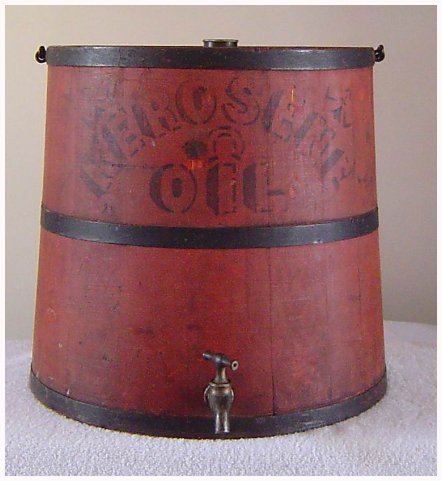 |
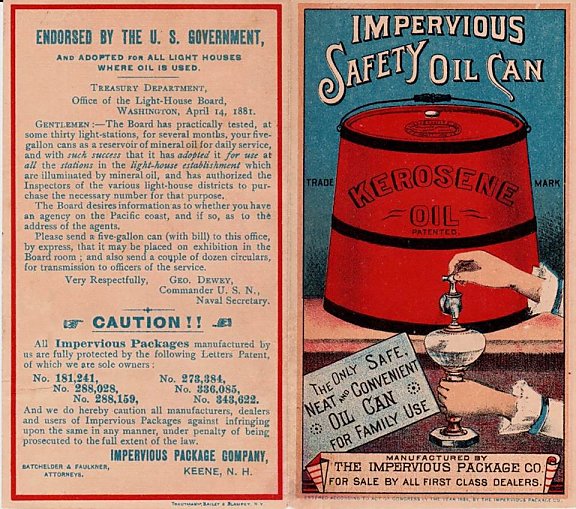 |
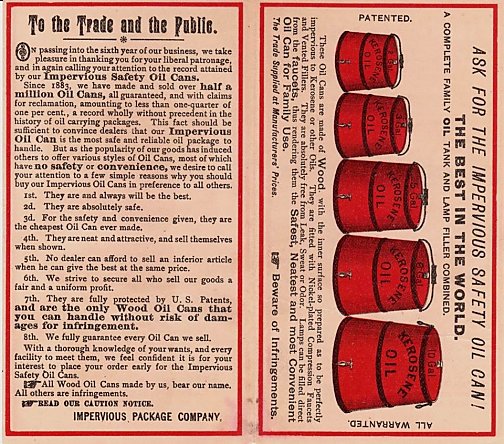 |
|
"Impervious Safety Oil
Can" sold a century ago for refilling lamps.
Owned and photographed by
Rob Hazelton |
COMMENT FROM A READER on kerosene tax rebate, Dec. 23, 2009
Hello,
I received your package of wicks today. Thanks for the
quick shipping.
I was speaking with my kerosene retailer today. There is
a $.243 per gallon Federal Tax on undyed Kerosene. This
is because the federal government considers kerosene a
motor fuel. Apparently years ago large trucking outfits
would mix kerosene with diesel and put in in their trucks
in the winter to prevent gelling. So now the government
taxes the fuel up front so they don't lose this revenue
stream.
However the federal government does make provisions for
people using kerosene for home heating purposes. If you
fill out and submit Form 4136 Credit for Federal Tax paid
on fuels, you will receive a rebate or tax credit for
this tax. You will need to keep an accurate accounting of
the amount of gallons used and receipts for all
purchases, should you get audited.
You may also be entitled to rebates on state taxes (if
they were collected) depending on the state and it's
particular laws.
Now Kerosene is looking more attractive as a fuel for my
home heating needs.
Maybe you could get something on your website, so that
kerosene users are aware they can get a
rebate? Philip P., NY
COMMENT FROM A READER, March 1,
2008
A few weeks ago, I
emailed you about a problem I was having with my heater.
You concluded that there could be water in the sump, and
you gave me instructions on how to deal with it. I want
to thank you for your help. You were 100% correct. I
pulled about 3 ounces of water from the sump. I have a
Toyostove DR-86. It isn't hard to get at the sump. I took
the whole stove apart and cleaned everything, and then I
did the alcohol treatment. After that, I dissassembled
everything and just put the stove parts on my bench for a
week and allowed everything to dry out. I assembled the
stove today, and it works great. Excellent flame and no
sputtering or odor. Thank you. Phil F.,
Pa.
INSTALLING AN OLD OIL TANK FOR
KEROSENE STORAGE
Standard oil
tanks are oval and hold 220 gallons. The fitting on the
front bottom is for 3/8" threaded pipe. The felt filters
for sludge and some water are also 3/8" pipe thread, so
it is relatively easy to attach them and have filtered
fuel (Many hardware stores sell fuel oil filter units for
about $20). To make filling kerosene containers easier, a
3/8" to �" adaptor is placed on a 3/8" pipe leading to
the edge of the tank, so a boiler valve with 3/4" garden
hose threads on the outlet can be used. Then a short
length of clear �" hose can be made and attached to the
boiler valve, and bottles or other containers filled
directly without spilling.
There are
fittings on the bottom corners of the tanks that take 1
1/4" pipe for legs, but they are relatively fragile. The
tank can be sat on the legs, but it can't be rocked
upright on them, so it must be carefully lifted, and that
means two strong men. I had only me, so I used pulleys,
levers, winches, etc, to carefully lift and move the tank
over the holes I dug for the legs...and still it was
hard.
I used 2 foot
long pipe legs. The fittings are 2 inches above the
bottom of the tank. I dug 6 inch deep trenches for each
set of legs, put a 1 inch piece of concrete in the holes
for the legs to stand on, and then took 1 gallon tin cans
with both ends cut out, slid them up over each leg, taped
them up in place, then lowered the tank into the
trenches. Then I leveled the tank so the legs were
solidly on the bottom (but level with a �" drop toward
the outlet end), filled the trenches with concrete, then
worked the gallon cans down about an inch into the
concrete and filled the cans with concrete too. That made
the legs very strong, anchored securely, and with the
concrete extending up the pipe legs for about 8 inches,
even the pipe legs are strengthened. The outlet valve is
about 16" above ground level, so filling small containers
is easy.
Most oil tanks
are installed lower than that for gravity feeding into a
basement. I installed mine high enough to fill a tall
bottle with kerosene right from the tap I put on after
the filter.
I cleaned the
inside of the tank by using a pressure sprayer and
diesel, spraying through the bungs on top of the tank,
and draining it out by removing the bung at the bottom,
right behind the 3/8" outlet on the end. What little
diesel remained is not enough to contaminate 220 gallons
of kero.
Then I had the
local oil company come out and deliver me 220 gallons of
#1 Kerosene stove oil, not furnace oil or #1 diesel, and
it had the red dye, of course. It works perfectly. I use
it in all of my kerosene heaters, and it burns
perfectly.
USING OTHER OLD TANKS FOR KEROSENE
STORAGE
It is sometimes
possible to find other old tanks which are perfectly
useable for kerosene storage. They may be of an odd
shape, but they can be used with a little ingenuity. I
found two old Mack truck saddle tanks, each holding 110
gallons. They made fine storage tanks after some
modifications and building cradles to hold them. To get
the kero out, I removed the 3/4" drain plug at the bottom
of one end and replaced the plug with a boiler valve,
then made up a short hose from clear 1/2" tubing and a
garden hose female replacement end, and that makes
filling bottles or jugs very easy indeed (see below,
barely visible on end of tank at left).
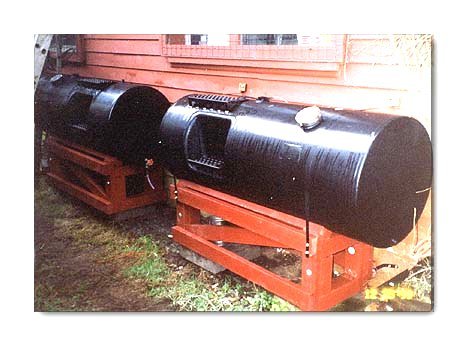
All of the tanks
I use were old, a little rusty, did not leak - and were
free. I cleaned the outside of the tanks with rags and
solvent, applied a thin film of Ospho to neutralize the
rust, let the Ospho dry in the sun for a day, then
painted the tanks with an automotive (metal) paint. New
tanks cost about $1.00 per gallon...$220 for a 220 gallon
tank, and they still need installation. If you have the
time and inclination, free tanks are worth the effort and
trouble.
|
Kerosene Heaters
Alphabetical list of most kerosene heaters and the proper wick,
& cart checkout.
List by wick number and the heaters that fit them. (A
helpful guide for buying on eBay)
Measurements needed if you have an unlisted heater.
Care and Maintenance of Kerosene Heater Wicks
Installing Kerosene Heater Wicks - generic for unpinned
wicks
Owner's_Manuals & information for many kerosene heaters
Kerosene
Heaters - General types, how they work, recommendations
for some good ones - and those I would avoid.
Economic Benefits of
Kerosene Heaters
Kerosene
Heater Safety
Regular
maintenance
Troubleshooting kerosene heater common problems
Breaking
In New Kerosene Appliances
Burning
Kerosene Heaters at Night
WATER IN KEROSENE causing "dwindling" and poor
performance.
Flame Spreader Heaters
and Lamps -
A Century of Excellence
Kerosene Heater Carts
-
why carry your heater around?
Kerosene Fuel Primer
Sweet
Smelling Kerosene
Kerosene tank cradles
(photo)
Building a Cradle
HALLER "ORIGINEEL"
STOVES
KEROSENE
HEATERS MADE IN THE NETHERLANDS
Beatrice Boiling Stoves & Mini kerosene heaters
you can make
Sad Iron stoves; Wicks &
Installation instructions
Wicking For Oil
Burning "WICKLESS" Stoves & Ranges
Photo Album
Photos of
Wicks
Mail Order
Form
Kerosene Stoves, Lanterns and Ovens
Kerosene Stoves -
Recommendations on different models
Kerosene
Stove Maintenance and Storage
Butterfly A-822, 22 wick, all-aluminum
premium stove.
Butterfly #2487, 16 wick stove.
Butterfly #2412 Pressure
Stove;
instructions for virtually any pressure stove.
Butterfly #2418
Double Burner Stove;
good with any gravity flow stove.
Butterfly #2421
Oven for Kerosene Stoves
Butterfly #2641, 10 Wick Stove
-
the least expensive emergency stove.
Butterfly #2698 Cook Stove -
THE Best Heavy Duty Cook Stove.
Butterfly
#828R Pressure Lantern;
same for most pressure lanterns.
Back to top of page
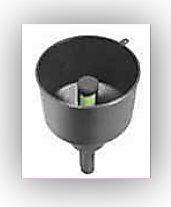
A "Mr. Funnel" filter is
excellent for removing water from kerosene. Water often
condenses in large fuel tanks, accumulating on the bottom of
the tank. The filter is used when filling smaller containers
from a storage tank. The purpose of this product is to
remove solid contamination down to 0.005" and free water. Free
water is the collection of water molecules in the bottom of
gas cans, tanks, or drums formed when fuel is stored. The RFF
filter will not remove emulsified water.
Emuslfied water can be
removed by adding a little alcohol to the fuel - no more than
1/3rd CC, 1/3rd teaspoon, PER GALLON, directly into the fuel
in the heater.
I have the smallest size Mr. Funnel filter in
stock. Click here.
Lamp Wicks:
Center Draft Wicks - Wicks
available only from this Wick Shop.
Flat lamp wicks
Aladdin Lamp Wicks
& parts
Lamp Chimneys:
Center Draft Lamp
chimneys
from "Tiny" Junior to Mammoth lamps.
Fabulous "Sans Rival"
borosilicate chimney for 14''' Kosmos lamps
Student Lamp Sans Rival Chimney with
1 7/8" fitter!!!
Standard glass lamp chimneys
Sonnenbrenner Lamp Chimneys
Information on lamps:
Center Draft Kerosene Lamps
(Photos, information and history, etc)
Photos of
restored center draft lamps
Care, Feeding and Restoration of Center Draft
Lamps
(and wick
installation for many)
Center Draft
Lamp manufacturers and brand names
Lamp Chimneys
- Dimension of
nominal base diameter by make, model and "line".
Early American Metal Font & Specialty Lamps
Aladdin Lamp History
Aladdin Lamp Wicks & Chimneys,
Aladdin - Exploded burner views
Kosmos-Brenner lamps
and wicks
Flame Spreaders and
"Smoke
Consumers"
from Alex
Marrack
- Vulcan, Imperial, Veritas,
Belgian, Hinks, Messenger's, Young's Court, etc.
Articles by Alex Marrack:
Home Page
Site Index
Site Index for all things Perfection
Kindler Wicking For Oil Stoves & Ranges
|












